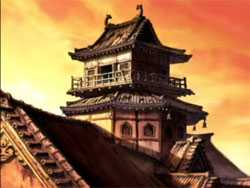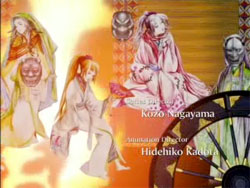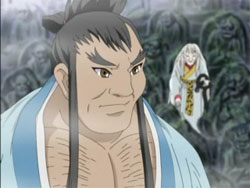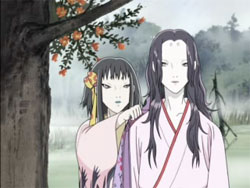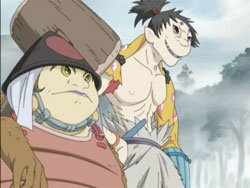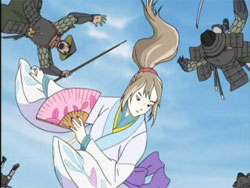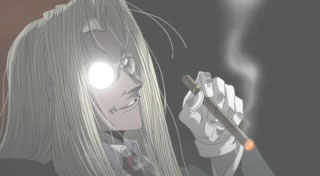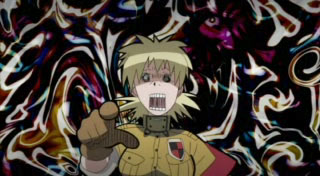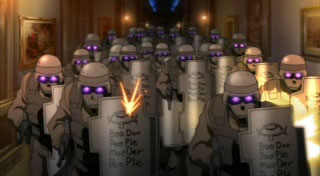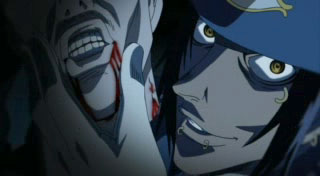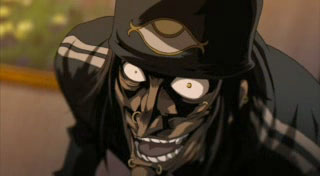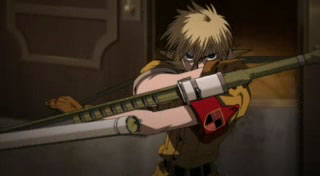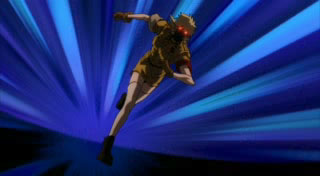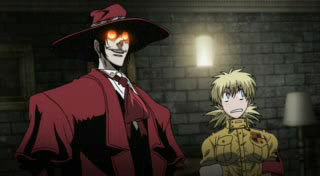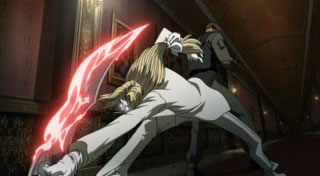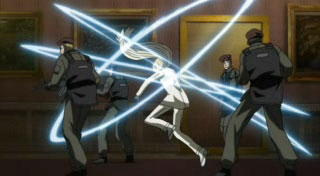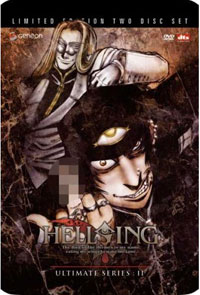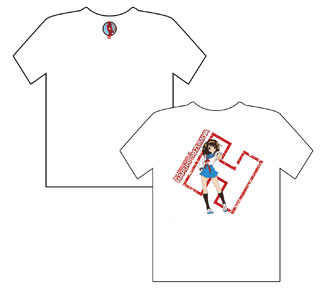 Logo handmade by Bannister
Column by Scott Green
Logo handmade by Bannister
Column by Scott Green
Eye Full of Horror Part 1-Introduction, Demon Prince Enma, The Drifting Classroom and Princess Resurrection Eye Full of Horror Part 2-When They Cry
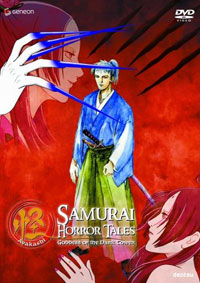
Anime Spotlight: Ayakashi - Samurai Horror Volume 1 Goddess of Dark Tower Released by Geneon
As a deep work to deconstruct, Ayakashi is fascinating. As a period supernatural spectacle, it proves more capable of dealing with small sights, like a neglected mountain side with a forest of carved statues or a lantern lit castle interior, than it does the grand ones, like a fierce battle between an army of men and a household of ancient spirits. Ayakashi's goal of presenting the tone of kabuki stories in anime appears to be too ambitious for the tools that this series had to work with. At its best, Ayakashi captures the atmosphere and conflicts of theatre in a new light that has touches from the other media, such as print screens, along with the anime meets giallo of Requiem From the Darkness or the anachronistic flair of Samurai Champloo. Evidently, Toei Animation did not have the budget to fully realize that vision, resulting in noticeable gaps in the prioritization. Many of the simplified motions and effects demystify the experience. This first block of Ayakashi episodes is not a homogenized period piece and not simply workable recounting of fairy tales, but with the compromises, it's also not singular the way that Requiem From the Darkness or the Hakkeden OVA of the 90's were.The first, four episode volume of Ayakashi comprises a complete retelling of Izumi Kyoka's kabuki play Tenshu Monogatari or Castle Tower. Written in 1917, the gothic romance looks back to the Edo era to follow the love affair between a man and a goddess who was never meant to interact with humanity. Young falconer Zushonosuke pursues his lost charge, and encounters Tomihime, the princess of a court of "forgotten gods" who rule over a remote castle. Zushonosuke finds that he cannot get the transcendently beautiful goddess out of his mind. Feeling drawn away from his human fiance, and pressured by his sadistic lord to enter the gods' castle to retrieve a special falcon, Zushonosuke ignores what he knows of the fate of humans who enter the castle and seeks to approach Tomihime again. The mythology serving as the backdrop for this story is that humanity and the forgotten gods came into existence at the same time. The two sets of beings where intended to be segregated, but gradually, the human domain expanded, and consumed the realm of the gods. Though the gods retreated to the unused spots in what had become a human world, this new order corrupted them. While beauty and sensations of the human world are entirely irrelevant to the gods, the creatures themselves possessed a beauty that enchanted men. One way or another, that was a deadly infatuation. The gods new lot was to remain immortal, but deteriorate, unless they slow the process by consuming humans. As one might guess from other fairy tales, a human who spends time in the forgotten gods domain will find that great lengths of time were lost in their own, and that a god who falls in love with a human will lose their immortality and die. The divide between the human world and spiritual world, along with the tradition of doomed love between a man and a goddess are threads in a knot that includes generational grudges, marital secrets and jealousy. Most of the time afforded to the story is spent on the affair and the imagery, but the anime does track into complimentary subjects. Zushonosuke's fiance has a nicely Shakespearian place in the plot, where she is both victim and instigator. A general is given a small role, primarily as an instrument of the plot. but the character also offers a window into the martial and political strategies of the age. The Zushonosuke/Tomihime tension between romantic desire, natural order and survival is lent provocative complexity by all these ancillary factors. The story is given an ending with unambiguous finality, but the conflicts its presents are not neatly wrapped up with pat resolutions. Together, all of the intentional and unintentional crimes defy balance sheet accounting of justification. Because Zushonosuke is too indecisive and causes too much harm to be strictly likable and his relationship with Tomihime follows a well known route, the story is not emotionally engaging. However, stopping to consider the anime, it does present a number of topics worth pondering. There are two sequences that occur early in the first episode, both of which justify at least renting the anime to see. The first is the opening credits, which are one of those mixed metaphors of modern and traditional aesthetic, recognized from Samurai Champloo or Afro Samurai. In Rhymester's "Heat Island", resonating shamisen strings are directed by scratches and beats. Meanwhile the backdrop alternates between the story's players represented in kaleidoscopic view and what looks to be a turning diorama. As it spins from scene to scene, the rotation reveals aspects of the design and of the characters. For example, the motion sends demon masks onto then off of the faces of the forgotten gods. The second is the prologue scene, which introduces the mood and artistry of the story. A small group of bandits move through rural mountains that look primordial in the mist. As they spy the forgotten gods' castle in the distance, they turn their back to a hillside full of statues. A hag creeps up on the group, and soon, they are being lead into the world of the gods. The impression of something alien, but as old as the mountains slowly encroaching on then replacing what is familiar, accompanied by the natural law that problems don't go away is some of the most effectively chilling material of the volume. The mountains around the castle, then its interior exhibit the complex background work of the anime. Inside, the craft of the anime labors hard to duplicate the craft of the period. Kimono clad court maids, stand in front of lantern lit printed screens and as the light is reflected off the lacquered floors, the direction of the production's effort is evident. Still, this sequence betrays the areas in which the production did not really concern itself. Impressive motion animation of the bandits' horses gingerly walking down a rocky slope is overshadowed by a lot of what looks to be struggling with the basics. Throughout the volume, basic motion and simple effects call attention to themselves as rougher, jerkier and simpler than would be expected. This is not a case of something radically different, that can be off-putting. It shouldn't be confused with stylized work, like Hisashi Mori's contribution to Samurai 7's episode 7. With figures being transposed across screen or shrunk, the short cuts are strikingly apparent. During the course of a nearly apocalyptic battle between men and gods, the constraints under which the animators were working keep manifesting themselves on screen. Many faults in anime are forgiven when conflicts are resolved with grand and exciting clashes. If the results explosive and runs smoothly, an anime can be successful without being new or innovative. The show stopping finale that this story had been building looks clumsy. If the notion of forgotten gods and doomed love didn't catch your interest, this ending will likely leave a bad impression of the anime.
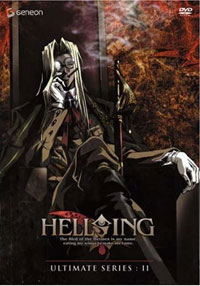
Anime Spotlight: Hellsing Ultimate OVA - Vol. 2 released by Geneon
Supernatural action stories afford anime productions the opportunity to stage the kind of high flying, full on attack fight scenes that many viewers seek out and expect from the anime tradition. Because it can be an easy vehicle, there is a propensity for these monster fighting centric titles to crowd the field. Consequently, nobody who follows anime is going to perk up automatically when a "vampires with guns" high concept is mentioned. What's noteworthy about Hellsing is that the franchise commands the attention of a sizable audience, including anime fans who have a jaded indifference to the genre. People who might not be generally inclined to get excited over works like Trinity Blood or Witch Hunter Robin have had an attentive eye on Hellsing Ultimate, which like many high profile OVA's (released direct to video in Japan), has had a slow and often delayed release history. The brilliance of Hellsing is knowingly surpassing expectations in its utilization of Nazis and vampires and buckets of blood without being encumbered by an author's sense of his own cleverness. Besides the consideration that after the first try at a Hellsing anime completed, Kouta Hirano's manga continued to go impressively more ga-ga insane, a new, from scratch anime adaptation was called for, because the earlier TV series did not appreciate that Hellsing was meant to be pulp with a post media saturation sensibility. The TV series lost support from being, by necessity, radically different from the manga, but it was also a bit more routine than what fans of the franchise might have hope for.Hellsing is a work that stems from having seen way too many kitschy horror movies with bright red arterial sprays, played too many video games, read and watched the original pulps and studied modern pastiches. Creator Kouta Hirano is an unabashedly scary geek. Anyone who has seen his manga, probably will not be surprised that before taking the idea for Hellsing into the relative mainstream, he tried out a number of aspects in violent, pornographic hentai manga. The entire second episode of Hellsing Ultimate is a 45 minute action set piece, and basically an assault on ... A pair of upstart vampire gangsters, backed by an army of ghoul shock troops in SWAT gear attack the headquarters of England's "Royal Order Of Protestant Knights", also known as the Hellsing organization. As the vampire and ghoul attackers decorate the walls of the manner house with the insides of its human guardians, the three operatives ready to repel the assault are the former police officer/rookie vampire Seras Victoria, 69 year old butler Walter Dornez (known as the "Angel of Death" in World War II) and the paragon of trench coat and shades clad monster-trouble shooters, Alucard. As the Hellsing organization's Inner Circle promote the fact that they are threatened by an opposing party with a level of supernatural knowledge that matches their own, a comedy routine is made out of Seras' outfitting for her new life as a warrior vampire. For interjected panels and epilogues, Hirano sketched out cartooned versions of his characters, and the anime follows suit. As Seras is given a coffin to sleep in and a 7 foot long "anti-freak cannon" to carry into combat, her screams are shown to shake the Hellsing manner. Few people or notions are taken seriously by the anime. While Seras is shown to be both dangerous as a vampire and competent as an ex-police officer, the anime has no reservation against using her as a source of amusement. For example, there is a (largely) unspoken joke about the size of her chest in rear end. The issue of her dimensions is presented more humorously than sexually, but almost every shot of the character emphasizes her rounder aspects. Outfitted in a literally foolish yellow uniform, (which was changed to a more reasonable looking blue in the TV adaptation) and frequently shown to be sporting cute-little fangs, the character is given a dementedly elfin quality. Hell comes to Hellsing with the arrival of the Valentine brothers, who resemble the imagined to be cool subject of a tragic gangster film. The younger Jan is dressed in black warm-ups, a beanie with an eye stitched in, and a pin cushion of facial piercings. His older sibling Luke goes for the opposite extreme: white suit, white overcoat, long blonde hair. Strolling down the lane, they don't seemed be a sophisticated threat to the likes of Alucard in their own right, but they are well prepared enough to be dangerous. Even before they make it to the gates, Jan's taunts sounds like Xbox live chatter with his trash talk. As soon as the grounds' guards take bullets to the head, the arrival of tour bus turned into armored personnel carriers is revealed. The players of the Hellsing anime are far from generic, but they don't really need much time to establish themselves. A few brisk minutes jumping between tense board room discussion, Alucard, Seras and Walter equipping themselves, an the Valentine brothers' verbal diarrhea is enough character development time before the blood can start pouring off ceilings. The rest of the episode is a close quarters war. A lot of people, with a lot of weapons are packed into a crowded space. One side is set on annihilating their opponent. The other is determined on annihilating AND devouring the first. It starts with 300 force against force skirmishing, but becomes more fantastic where it is less about pounding the foe and more about who has the nicer effect, and this evolution of the fights offers some clever variety to the action. The fight makes a bold statement early on by blowing half the head off a ghoul and not blinking as the creature continues to advance forward. There is an immense amount of unpleasantness on screen, underscored by a level and volume of brutality that etches a deep impression. Moments like Jan scratching himself with a severed hand and later, bouncing a head in his hand, licking it, fondling an eyeball, then crushing the eye in its socket are bound to be memorable. The impact of the attack and strangeness of its attackers are emphasized by a mix of fighters who plainly don't feel pain and don't react to a point blank gunshot to the skull and fighters who do and react to a punch, stomped on hand or submission hold. And, a nasty attitude comes into play through glib touches, such a phalanx of body shields bearing a scrawled eye and the message "Boo Boo Murder People" or the pathologically inappropriate pop-culture references worked into Jan's taunts. At the same time, it is that glibness that makes the episode watchable and not a misanthropic grind. Like the Evil Dead movies, it might be severe, but it is not serious. The original Hellsing anime was produced by Gonzo. In the late 90's the studio was something new. By now, they've settled into something of a known quantity. Despite some experimental or distinctive works, those who recognize their name greet it with the guarded hope that what looks promising will be persistent throughout the given work. Hellsing Ultimate was produced by Satelight, who are similarly a relatively new studio, but one that has remained a dark horse. Some of the studio's attitudes seem inherited from its executive director Shoji Kawamori. Kawamori went from designing mecha on Macross, to directing more mature (Macross Plus) or heady (Escaflowne) versions of genre standards. Then, at least in the eyes of his American fans, began alienating viewers with confrontational work like the spiritually environmentalist Arjuna. In keeping with that resume, Satelight has done very populist works (Galaxy Angel Rune), shifted genre fair (Heat Guy J, Geneshaft, Aquarion ) and unique statements (Noein). The net of this is you wouldn't know exactly what you're going to get from a Satelight Hellsing OVA, except that it would look different from what any other studio's approach to the source. Director Tomokazu Tokoro similarly has a history of offbeat works (NieA_7, Haibane Renmei). In the case of Hellsing, he has almost anti-choreographed the central action. That's not to say that the fights are static or reliant on short cuts, but they aren't a fluid dance either. Rather, they are phrased as a debate. To an exaggerated degree, in every exchange, one side does their worst, the other attempts to absorb and then retaliate. Each aspect of offense and defense is keyed in on making a statement. For example dodging is rare in this punch-for-punch mode but impressively animated and present, and again, when it happens, it is to prove a point. In a more global sense, the anime has its own visual style. In a manner that is more in keeping with the common features of manga than anime, it is very facially focused. All actions are gauged by reaction shots of the characters' faces. What ever happens, the direction returns to tighten in on an inescapably close expression. The effects have evolved since the first volume. It could be the different nature of the battles, but the dusty, earthy quality to the moving shadows and attacked spirits has abated. However, the effects are still very manga based. A lot of old tricks are revived and revitalized. Some of this calls to mind classic moments of intricate animation. For a long standing fan, it is hard to think of a well animated sequence in which someone, mid-air, dodges a swarm of projectiles without Macross coming to mind. Other cases work off more basic ideas. Moving between the volcanic expositions or hails of gunfire, old-fashion speedlines and digitally animated blurs propel the characters. Tokoro works out paths in which the classic and the fresh can complement each other. As Luke Valentine zips though a crowd of soldiers, set to funky electronica, with a screeching noise, and glowing vector trail, Fist of the North Star comes to mind, as does Matrix bullet time, and still, here, the elements form into their own spectacle. To its credit, Hellsing Ultimate never tries to fake something higher than it is. It doesn't intellectualize anything and everything is more adrenaline than emotion. Even the episode's denouncement and epilogue are not heavy handed or moralistic. The condemnation, the morning and hurrumpth-ing English gentlemen do not stand to criticize the viewer for delighting in the earlier, over-the-top carnage. Instead, it serves as a reason for the protagonists to be more intently determined and angry for the next round. Special Edition bonuses MAIN FEATURE DISC - 16x9 Anamophic Widescreen - 5.1 DTS English Audio - 5.1 Dolby Digital English Audio - 5.1 Dolby Digital Japanese Audio - Audio Commentary EXTRA DISC - Staff Interview Featuring A Round-Table Discussion With ADR Director Taliesin Jaffe And Voice Actors Patrick Seitz (Luke Valentine) and Josh Phillips (Jan Valentine) LIMITED EDITION COMES WITH: - SteelBook case - Extra Feature Disc - A 200-Page Production Art Collection Book
Previews
A trailer for Appleseed Saga: Ex Machina has gone online here. The movie will premiere in Japanese theaters this fall. New York Magazine has a preview of Vertical's release of Osamu Tezuka manga Apollo's Song here Anime News Network notes Goo has an English language trailer for GONZO's Romeo x Juliet.
More Haruhi T-shirts
Right Stuf, Inc. and Nozomi Entertainment announced the Fall 2007 release of two official T-shirts featuring artwork from the hit anime series The Melancholy of Haruhi Suzumiya. The first T-shirt depicts Haruhi, herself, in full-color against a white background, while the second displays the ìHaruhi-ismî logo against a gray background. Both retail for $17.99 (XXL $19.99)
Paul Pope Releases from First Second Books
First Second Books announced its plan to publish Paul Pope's highly anticipated multi-volume Martian epic, TOTAL THB, as well as an original commission for young readers, BATTLING BOY. Pope's sprawling TOTAL THB-a full-color, four-volume set totaling over 1200 pages-is scheduled to release in 2009. (An oversize Deluxe Collectors edition in black and white is planned as well). TOTAL THB will include the never-before-seen final chapters of the story, whose teenage heroine HR Watson comes of age on Mars with her extraordinary protector 'THB', a water-activated, inflatable bodyguard. BATTLING BOY, to be published as a series in two simultaneous volumes, introduces a youthful hero who faces off against various demons in the city of Monstropolis. It will be released by First Second in 2008. Says Pope, "I'm excited about the alliance THB will have with First Second. Mark Siegel is an old-time fan of the series, and together we will finally be getting the entire THB story out there-in full color and in a series of beautifully designed trade paperbacks, falling right on the heels of BATTLING BOY." Dubbed the "Jim Morrison of American comics", Pope has earned a sizeable reputation in the industry with his virtuoso brushwork and unmistakable blend of American, Japanese, and European influences. THB-Pope's magnum opus-has gained an international audience through his self-published serialization. Pope concludes, "I've always called THB my Dune. THB is the American Akira. It's big and shimmering and strange and new, and hopefully it will reach a wide audience of readers who really love comics."
New Star Trek OEL Manga From TOKYOPOP
TOKYOPOP and CBS Consumer Products announced that they will be developing a second volume of original English language manga, entitled Star Trek: The Manga: Kakan Ni Shinkou. Creators involved include author/actor Wil Wheaton (ëWesley Crusherí on Star Trek: The Next Generation), Diane Duane (author of 11 Star Trek novels and writer for numerous TV shows including Star Trek: The Next Generation), Mike Wellman (Mac Afro), Paul Benjamin (Pantheon High) and Christine Boylan (CBS TVís 3 Lbs.), with accompanying art by EJ Su (Transformers), Don Hudson (Gun Powder Girl and the Outlaw Squaw), Steven Cummings (Pantheon High), Bettina Kurkoski (My Cat Loki) and Nam Kim (Adomant).
1-18-08 / Cloverfield Again...
Todd Tennant of American Kaiju sent us another of his interpretations of the much talked about 1-18-08
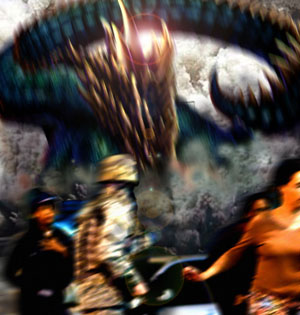
Anime Rap
MAJA, a rapper whose subject include anime, video games and Japanese culture, is putting together his new album debut - The Amalgam Project" set to release in August/September 2007. He'll be appearing Friday 7/27 at the Bossfight & Nerdy Mag Presents-N3XT L3V3L CONCER, which will be held San Diego Sports Club 1271 University Ave., San Diego, CA The event starts at 7:00pm

